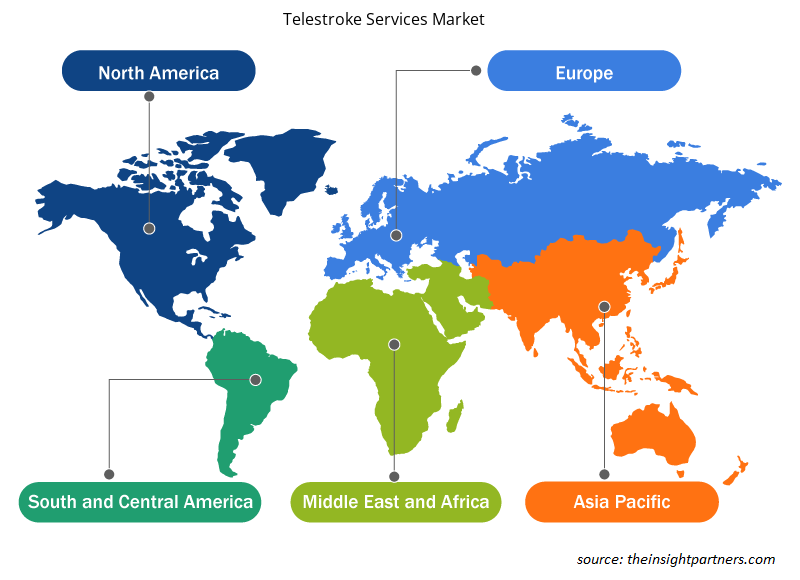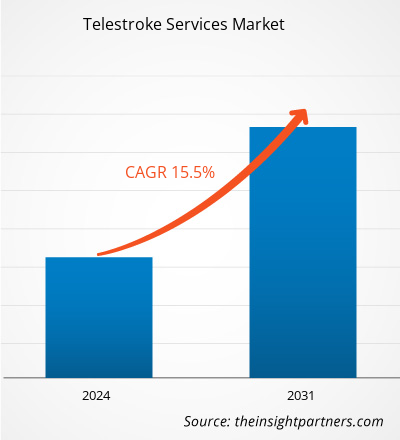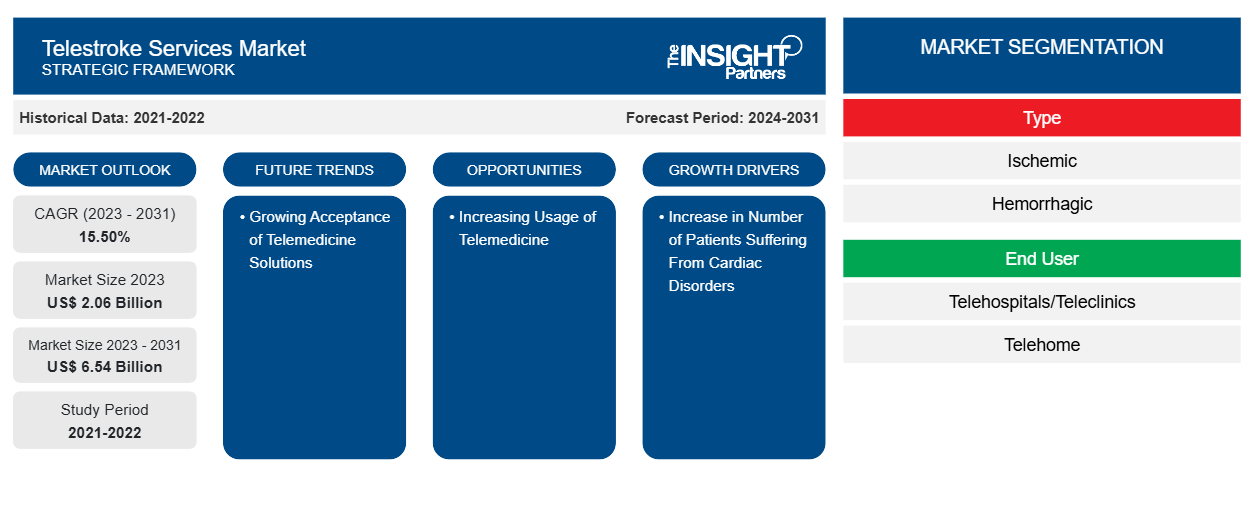Si prevede che la dimensione del mercato dei servizi di telestroke raggiungerà i 6,54 miliardi di dollari entro il 2031, rispetto ai 2,06 miliardi di dollari del 2023. Si prevede che il mercato registrerà un CAGR del 15,50% nel periodo 2023-2031.L'avvento di prodotti tecnologicamente avanzati continuerà probabilmente a rappresentare una tendenza fondamentale sul mercato.
Analisi di mercato dei servizi Telestroke
Il mercato si sta espandendo a causa sia del numero di pazienti cardiovascolari che abbandonano il centro sia della crescente incidenza globale di casi di ictus. Si prevede che il mercato crescerà a causa della crescente incidenza di malattie cardiovascolari e ictus e del crescente utilizzo di telemedicina, tecnologia all'avanguardia e servizi di telestroke. Si prevede che politiche di rimborso di supporto e un elevato tasso di adozione di servizi di telemedicina e telestroke spingeranno il mercato dei servizi di telestroke. Si prevede che la regione Asia-Pacifico crescerà eccessivamente a causa dell'aumento dei lanci di prodotti, del miglioramento delle infrastrutture sanitarie e dei progressi tecnologici.
Panoramica del mercato dei servizi Telestroke
Una delle principali cause di morte e disabilità nel mondo è l'ictus. L'ictus è stata la seconda causa di morte più comune, secondo l'Organizzazione Mondiale della Sanità (OMS) nel 2016. L'ictus è un problema di salute pubblica significativo che danneggia la società e l'economia. Nei prossimi decenni, il peso dell'ictus sulla salute pubblica aumenterà a causa dei cambiamenti demografici, soprattutto nelle nazioni in via di sviluppo. Pertanto, il crescente numero di casi di ictus aumenterà l'accettazione delle soluzioni di telemedicina, guidando così la crescita del mercato.
Personalizza questo report in base alle tue esigenze
Riceverai la personalizzazione gratuita di qualsiasi report, comprese parti di questo report, o analisi a livello nazionale, pacchetto dati Excel, oltre a usufruire di grandi offerte e sconti per start-up e università
- Scopri le principali tendenze di mercato in questo rapporto.Questo campione GRATUITO includerà analisi di dati che spaziano dalle tendenze di mercato alle stime e alle previsioni.
Driver e opportunità di mercato dei servizi Telestroke
L'aumento del numero di pazienti affetti da disturbi cardiaci favorisce la crescita del mercato
A livello globale, le malattie cardiovascolari (CVD) sono tra le principali cause di morte. L'Organizzazione Mondiale della Sanità stima che 17,9 milioni di decessi in tutto il mondo nel 2019 siano stati correlati a CVD, ovvero il 32% di tutti i decessi. Inoltre, infarti e ictus sono stati la causa dell'85% di questi decessi. Le nazioni a basso e medio reddito rappresentano almeno il 75% dei decessi correlati a malattie cardiovascolari in tutto il mondo.CVDs) rank among the top causes of death. The World Health Organization estimates that 17.9 million deaths worldwide in 2019 were related to CVDs or 32% of all deaths. Moreover, heart attacks and strokes were the cause of 85% of these fatalities. Low- and middle-income nations account for at least 75% of cardiovascular disease-related deaths worldwide.
Inoltre, rispetto alla popolazione generale, i pazienti cardiaci hanno un rischio notevolmente aumentato di malattie cardiache e ictus. Si ritiene che il fattore di rischio predisponente più significativo per l'ictus ischemico acuto (AIS) sia la CVD. Nei pazienti con coronaropatia , l'incidenza di AIS raddoppia e nei pazienti con fibrillazione atriale, si moltiplica per cinque. Inoltre, i pazienti con ictus sono particolarmente suscettibili a gravi eventi avversi cardiaci perché il danno cerebrale può modificare i percorsi autonomi e neuroormonali che regolano la funzione cardiaca. In particolare, l'autoregolazione cerebrale può essere compromessa dall'AIS, con conseguente dipendenza del flusso sanguigno cerebrale dalla funzione cardiaca. I medici specializzati in cardiologia e ictus collaborano a stretto contatto con i partner del settore per sviluppare strumenti, risorse e trattamenti che possano aiutare a ridurre i tempi di trattamento e migliorare l'efficienza. Il mercato sta crescendo a causa della domanda aumentata e dell'adozione di servizi di telestroke causati dalla maggiore frequenza di questi casi di CVD.
Utilizzo crescente della telemedicinaTelemedicine
I servizi medici gestiscono malattie e problemi clinici complessi in modo efficiente e tempestivo. Tuttavia, con l'invecchiamento della popolazione e l'aumento della prevalenza di malattie croniche, aumenta la necessità di servizi medici, con conseguente aumento dei costi e pressione sui sistemi sanitari . Per oltre trent'anni, la telemedicina è stata utilizzata dai professionisti sanitari per curare le vittime di ictus. La tecnologia è nata come piattaforma audiovisiva, consentendo ai neurologi di osservare un paziente che manifestava sintomi di ictus. I servizi di teleictus, che utilizzano canali sanitari connessi per aumentare la diagnosi e il trattamento delle vittime di ictus, stanno aiutando i sistemi sanitari di tutto il mondo a salvare vite. Il Furthering Access to Stroke Telemedicine (FAST) Act faceva parte del Creating High-Quality Results and Outcomes Needed to Improve Chronic (CHRONIC) Care Act del 2017. Con la revoca delle restrizioni rurali e l'espansione dell'assicurazione sanitaria ospedaliera per coprire i servizi di teleictus a partire dal 2021, questa legge potrebbe consentire a un numero maggiore di pazienti con ictus di ricevere servizi di telemedicina. Pertanto, si prevede che il mercato dei servizi di teleictus presenterà opportunità nei prossimi anni a causa dei fattori sopra menzionati.telemedicine has been utilized by healthcare professionals to treat stroke victims. The technology started as an audio-visual platform, allowing neurologists to observe a patient exhibiting stroke symptoms. Telestroke services, which use connected healthcare channels to increase the diagnosis and treatment of stroke victims, are helping healthcare systems worldwide save lives. The Furthering Access to Stroke Telemedicine (FAST) Act was a part of the Creating High-Quality Results and Outcomes Needed to Improve Chronic (CHRONIC) Care Act of 2017. With the lifting of rural restrictions and the expansion of hospital health insurance to cover telestroke services starting in 2021, this act may enable more stroke patients to receive telehealth services. Thus, the telestroke services market is anticipated to present opportunities in the upcoming years due to the factors above.
Analisi della segmentazione del rapporto di mercato dei servizi Telestroke Services Market Report Segmentation Analysis
I segmenti chiave che hanno contribuito alla derivazione dell'analisi di mercato dei servizi Telestroke sono la tipologia e l'utente finale.
- In base al tipo, il mercato dei servizi di telestroke è suddiviso in ischemico ed emorragico. Il segmento ischemico ha detenuto la quota di mercato più significativa nel 2023.
- In base all'utente finale, il mercato è segmentato in teleospedali/telecliniche, telehome e altri. Il segmento teleospedali/telecliniche ha detenuto la quota maggiore del mercato nel 2023.
Analisi della quota di mercato dei servizi Telestroke per area geografica
L'ambito geografico del rapporto di mercato sui servizi di telestroke è suddiviso principalmente in cinque regioni: Nord America, Asia Pacifico, Europa, Medio Oriente e Africa, e Sud e Centro America.
Grazie alla presenza di importanti attori del mercato, alla crescita dei settori sanitario e della ricerca nella regione e ad altri fattori, si prevede che il mercato dei servizi di telestroke nella regione registrerà una crescita significativa nel periodo di previsione. Inoltre, la crescente consapevolezza della telemedicina nella regione, migliori strutture sanitarie e linee guida di rimborso adeguate stanno aumentando la domanda di servizi di telestroke in Nord America. La regione Asia-Pacifico avrà abbondanti opportunità di crescita durante il periodo di previsione grazie ai crescenti investimenti, ai progressi tecnologici e all'aumento dei lanci di nuovi prodotti.
Approfondimenti regionali sul mercato dei servizi Telestroke
Le tendenze regionali e i fattori che influenzano il Telestroke Services Market durante il periodo di previsione sono stati ampiamente spiegati dagli analisti di Insight Partners. Questa sezione discute anche i segmenti e la geografia del Telestroke Services Market in Nord America, Europa, Asia Pacifico, Medio Oriente e Africa e Sud e Centro America.

- Ottieni i dati specifici regionali per il mercato dei servizi Telestroke
Ambito del rapporto di mercato sui servizi Telestroke
| Attributo del report | Dettagli |
|---|---|
| Dimensioni del mercato nel 2023 | 2,06 miliardi di dollari USA |
| Dimensioni del mercato entro il 2031 | 6,54 miliardi di dollari USA |
| CAGR globale (2023-2031) | 15,50% |
| Dati storici | 2021-2022 |
| Periodo di previsione | 2024-2031 |
| Segmenti coperti | Per tipo
|
| Regioni e Paesi coperti | America del Nord
|
| Leader di mercato e profili aziendali chiave |
|
Densità degli attori del mercato: comprendere il suo impatto sulle dinamiche aziendali
Il mercato dei servizi Telestroke sta crescendo rapidamente, spinto dalla crescente domanda degli utenti finali dovuta a fattori quali l'evoluzione delle preferenze dei consumatori, i progressi tecnologici e una maggiore consapevolezza dei vantaggi del prodotto. Con l'aumento della domanda, le aziende stanno ampliando le loro offerte, innovando per soddisfare le esigenze dei consumatori e capitalizzando sulle tendenze emergenti, il che alimenta ulteriormente la crescita del mercato.
La densità degli operatori di mercato si riferisce alla distribuzione di aziende o società che operano in un particolare mercato o settore. Indica quanti concorrenti (operatori di mercato) sono presenti in un dato spazio di mercato in relazione alle sue dimensioni o al valore di mercato totale.
Le principali aziende che operano nel mercato dei servizi Telestroke sono:
- Servizi sanitari e di Providence
- Partner Centro Telestroke
- Università di medicina della Carolina del Sud
- Sistema sanitario di Granville
- Sistema sanitario di Lakewood
Disclaimer : le aziende elencate sopra non sono classificate secondo un ordine particolare.

- Ottieni una panoramica dei principali attori del mercato dei servizi Telestroke
Notizie di mercato e sviluppi recenti sui servizi Telestroke
Il mercato dei servizi di telestroke viene valutato raccogliendo dati qualitativi e quantitativi dopo la ricerca primaria e secondaria, che include importanti pubblicazioni aziendali, dati di associazioni e database. Di seguito sono elencati alcuni degli sviluppi nel mercato dei servizi di telestroke:
- UPMC ha ampliato i servizi di assistenza specialistica per l'ictus presso UPMC Cole offrendo servizi di consulenza virtuale 24 ore su 24, 7 giorni su 7, 365 giorni all'anno con specialisti dell'ictus di fama mondiale dell'UPMC Stroke Institute presso UPMC Presbyterian, un centro certificato per l'ictus completo. (Fonte: UPMC, comunicato stampa, gennaio 2024)
- Il Lakewood Ranch Medical Center ha ricevuto il premio "Get With The Guidelines-Stroke Gold Plus Quality Achievement" dell'American Heart Association/American Stroke Association. Il premio riconosce l'impegno dell'ospedale nel garantire che i pazienti colpiti da ictus ricevano il trattamento più appropriato secondo le linee guida riconosciute a livello nazionale e basate sulla ricerca, basate sulle più recenti prove scientifiche. (Fonte: Lakewood Ranch Medical Center, comunicato stampa, agosto 2020)
Copertura e risultati del rapporto di mercato sui servizi Telestroke
Il rapporto "Dimensioni e previsioni del mercato dei servizi Telestroke (2021-2031)" fornisce un'analisi dettagliata del mercato che copre le seguenti aree:
- Dimensioni e previsioni del mercato dei servizi Telestroke a livello globale, regionale e nazionale per tutti i segmenti di mercato chiave coperti dall'ambito
- Tendenze del mercato dei servizi Telestroke e dinamiche di mercato come driver, restrizioni e opportunità chiave
- Analisi dettagliata delle cinque forze PEST/Porter e SWOT
- Analisi di mercato dei servizi Telestroke che copre le principali tendenze del mercato, il quadro globale e regionale, i principali attori, le normative e i recenti sviluppi del mercato.
- Analisi del panorama industriale e della concorrenza che copre la concentrazione del mercato, l'analisi della mappa di calore, i principali attori e gli sviluppi recenti per il mercato dei servizi di telestroke
- Profili aziendali dettagliati
- Analisi storica (2 anni), anno base, previsione (7 anni) con CAGR
- Analisi PEST e SWOT
- Valore/volume delle dimensioni del mercato - Globale, Regionale, Nazionale
- Industria e panorama competitivo
- Set di dati Excel
Report recenti
Testimonianze
Motivo dell'acquisto
- Processo decisionale informato
- Comprensione delle dinamiche di mercato
- Analisi competitiva
- Analisi dei clienti
- Previsioni di mercato
- Mitigazione del rischio
- Pianificazione strategica
- Giustificazione degli investimenti
- Identificazione dei mercati emergenti
- Miglioramento delle strategie di marketing
- Aumento dell'efficienza operativa
- Allineamento alle tendenze normative





















 Ottieni un campione gratuito per - Mercato dei servizi Telestroke
Ottieni un campione gratuito per - Mercato dei servizi Telestroke